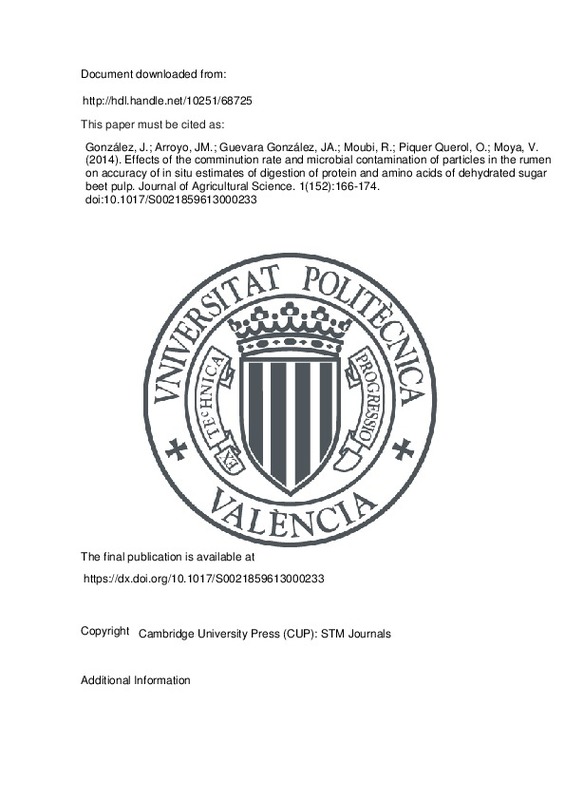Milgen, J. V., & Baumont, R. (1995). Models based on variable fractional digestion rates to describe ruminal in situ digestion. British Journal of Nutrition, 73(6), 793-807. doi:10.1079/bjn19950085
Rodríguez, C. A., González, J., Alvir, M. R., Repetto, J. L., Centeno, C., & Lamrani, F. (2000). Composition of bacteria harvested from the liquid and solid fractions of the rumen of sheep as influenced by feed intake. British Journal of Nutrition, 84(3), 369-376. doi:10.1017/s0007114500001653
Rodríguez, C. A., & González, J. (2006). In situ study of the relevance of bacterial adherence to feed particles for the contamination and accuracy of rumen degradability estimates for feeds of vegetable origin. British Journal of Nutrition, 96(2), 316-325. doi:10.1079/bjn20061830
[+]
Milgen, J. V., & Baumont, R. (1995). Models based on variable fractional digestion rates to describe ruminal in situ digestion. British Journal of Nutrition, 73(6), 793-807. doi:10.1079/bjn19950085
Rodríguez, C. A., González, J., Alvir, M. R., Repetto, J. L., Centeno, C., & Lamrani, F. (2000). Composition of bacteria harvested from the liquid and solid fractions of the rumen of sheep as influenced by feed intake. British Journal of Nutrition, 84(3), 369-376. doi:10.1017/s0007114500001653
Rodríguez, C. A., & González, J. (2006). In situ study of the relevance of bacterial adherence to feed particles for the contamination and accuracy of rumen degradability estimates for feeds of vegetable origin. British Journal of Nutrition, 96(2), 316-325. doi:10.1079/bjn20061830
Pereira, J. C., & González, J. (2004). Rumen degradability of dehydrated beet pulp and dehydrated citrus pulp. Animal Research, 53(2), 99-110. doi:10.1051/animres:2004005
Mahadevan, S., Erfle, J. D., & Sauer, F. D. (1980). Degradation of Soluble and Insoluble Proteins by Bacteroides Amylophilus Protease and by Rumen Microorganisms2. Journal of Animal Science, 50(4), 723-728. doi:10.2527/jas1980.504723x
Li, X., Kieliszewski, M., & Lamport, D. T. A. (1990). A Chenopod Extensin Lacks Repetitive Tetrahydroxyproline Blocks. Plant Physiology, 92(2), 327-333. doi:10.1104/pp.92.2.327
Grenet, E., & Barry, P. (1990). In vivo and in sacco digestibility and rumen microbial degradation of cell walls of soyabean and rape integuments and of dehydrated beet pulp in sheep, observed by scanning electron microscopy. The Journal of Agricultural Science, 115(3), 429-435. doi:10.1017/s0021859600075882
González, J., Faría-Mármol, J., Arroyo, J. M., Centeno, C., & Martínez, A. (2010). Effects of ensiling onin situruminal degradability and intestinal digestibility of corn forage. Archives of Animal Nutrition, 64(3), 204-220. doi:10.1080/17450391003691450
González, J., Ouarti, M., Rodríguez, C. A., & Alvir, M. R. (2006). Effects of considering the rate of comminution of particles and microbial contamination on accuracy of in situ studies of feed protein degradability in ruminants. Animal Feed Science and Technology, 125(1-2), 89-98. doi:10.1016/j.anifeedsci.2005.05.013
Arroyo, J. M., & González, J. (2011). Effects of the ruminal comminution rate and microbial contamination of particles on accuracy ofin situestimates of ruminal degradability and intestinal digestibility of feedstuffs. Journal of Animal Physiology and Animal Nutrition, 97(1), 109-118. doi:10.1111/j.1439-0396.2011.01248.x
Alcaide, E. M., Garcı́a, A. I. M., & Aguilera, J. . (2000). A comparative study of nutrient digestibility, kinetics of degradation and passage and rumen fermentation pattern in goats and sheep offered good quality diets. Livestock Production Science, 64(2-3), 215-223. doi:10.1016/s0301-6226(99)00149-9
Udén, P., Colucci, P. E., & Van Soest, P. J. (1980). Investigation of chromium, cerium and cobalt as markers in digesta. Rate of passage studies. Journal of the Science of Food and Agriculture, 31(7), 625-632. doi:10.1002/jsfa.2740310702
Barrie, A., Brookes, S. T., Prosser, S. J., & Debney, S. (1995). High productivity analysis of15N and13C in soil/plant research. Fertilizer Research, 42(1-3), 43-59. doi:10.1007/bf00750499
Van Soest, P. J., Robertson, J. B., & Lewis, B. A. (1991). Methods for Dietary Fiber, Neutral Detergent Fiber, and Nonstarch Polysaccharides in Relation to Animal Nutrition. Journal of Dairy Science, 74(10), 3583-3597. doi:10.3168/jds.s0022-0302(91)78551-2
Dhanoa, M. S., Siddons, R. C., France, J., & Gale, D. L. (1985). A multicompartmental model to describe marker excretion patterns in ruminant faeces. British Journal of Nutrition, 53(3), 663-671. doi:10.1079/bjn19850076
Showalter, A. M. (1993). Structure and function of plant cell wall proteins. The Plant Cell, 5(1), 9-23. doi:10.1105/tpc.5.1.9
BERNARD, L., MARVALIN, O., YANG, W. Z., & PONCET, C. (1988). Colonisation bactérienne de différents types d’aliments incubés in sacco dans le rumen ; conséquences pour l’estimation de la dégradabilité de l’azote. Reproduction Nutrition Développement, 28(Suppl. 1), 105-106. doi:10.1051/rnd:19881127
González, J., Ouarti, M., Rodríguez, C. A., & Centeno, C. (2009). A simplified management of thein situevaluation of feedstuffs in ruminants: Application to the study of the digestive availability of protein and amino acids corrected for the ruminal microbial contamination. Archives of Animal Nutrition, 63(4), 304-320. doi:10.1080/17450390903020463
Van Milgen, J., Murphy, M. R., & Berger, L. L. (1991). A Compartmental Model to Analyze Ruminal Digestion. Journal of Dairy Science, 74(8), 2515-2529. doi:10.3168/jds.s0022-0302(91)78429-4
[-]







![[Cerrado]](/themes/UPV/images/candado.png)

